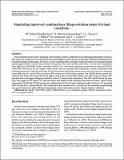Por favor, use este identificador para citar o enlazar a este item:
http://hdl.handle.net/10261/292140COMPARTIR / EXPORTAR:
 SHARE SHARE
 CORE
BASE CORE
BASE
|
|
| Visualizar otros formatos: MARC | Dublin Core | RDF | ORE | MODS | METS | DIDL | DATACITE | |

| Título: | Simulating improved combinations tillage-rotation under dryland conditions |
Autor: | Soldevilla-Martinez, M.; Martín Lammerding, Diana; Tenorio, J. L.; Walter, I.; Quemada, Miguel; Lizaso, J. I. | Palabras clave: | CENTURY model CERES-Barley Crop simulation models DSSAT Sequential simulation Soil organic carbon |
Fecha de publicación: | 2013 | Editor: | CSIC - Instituto Nacional de Investigación y Tecnología Agraria y Alimentaria (INIA) | Citación: | Spanish Journal of Agricultural Research 11(3): 820-832 (2013) | Resumen: | Crop simulation models allow analyzing various tillage-rotation combinations and exploring management scenarios. This study was conducted to test the DSSAT (Decision Support System for Agrotechnology Transfer) modelling system in rainfed semiarid central Spain. The focus is on the combined effect of tillage system and winter cereal-based rotations (cereal/legume/fallow) on the crop yield and soil quality. The observed data come from a 16-year field experiment. The CERES and CROPGRO models, included in DSSAT v4.5, were used to simulate crop growth and yield, and DSSATCENTURY was used in the soil organic carbon (SOC) and soil nitrogen (SN) simulations. Genetic coefficients were calibrated using part of the observed data. Field observations showed that barley grain yield was lower for continuous cereal (BB) than for vetch (VB) and fallow (FB) rotations for both tillage systems. The CERES-Barley model also reflected this trend. The model predicted higher yield in the conventional tillage (CT) than in the no tillage (NT) probably due to the higher nitrogen availability in the CT, shown in the simulations. The SOC and SN in the top layer only, were higher in NT than in CT, and decreased with depth in both simulated and observed values. These results suggest that CT-VB and CT-FB were the best combinations for the dry land conditions studied. However, CT presented lower SN and SOC content than NT. This study shows how models can be a useful tool for assessing and predicting crop growth and yield, under different management systems and under specific edapho-climatic conditions. | URI: | http://hdl.handle.net/10261/292140 | DOI: | 10.5424/sjar/2013113-3747 | ISSN: | 1695-971-X | E-ISSN: | 2171-9292 |
| Aparece en las colecciones: | (INIA) Artículos |
Ficheros en este ítem:
| Fichero | Descripción | Tamaño | Formato | |
|---|---|---|---|---|
| 1606.PDF | 100,17 kB | Adobe PDF |  Visualizar/Abrir |
CORE Recommender
SCOPUSTM
Citations
12
checked on 11-may-2024
WEB OF SCIENCETM
Citations
10
checked on 27-feb-2024
Page view(s)
21
checked on 16-may-2024
Download(s)
48
checked on 16-may-2024
Google ScholarTM
Check
Altmetric
Altmetric
Este item está licenciado bajo una Licencia Creative Commons

